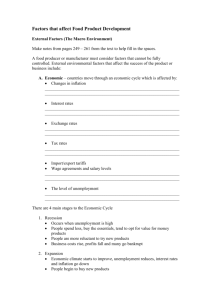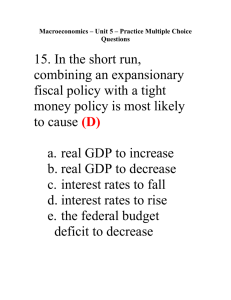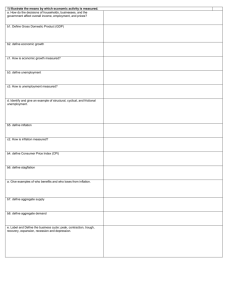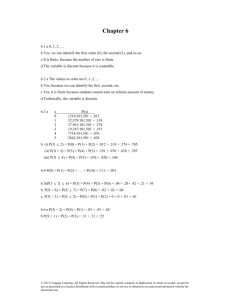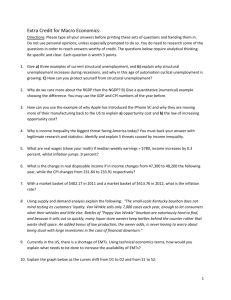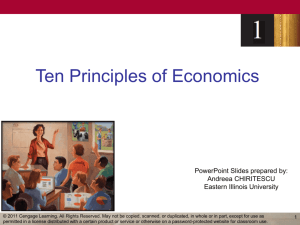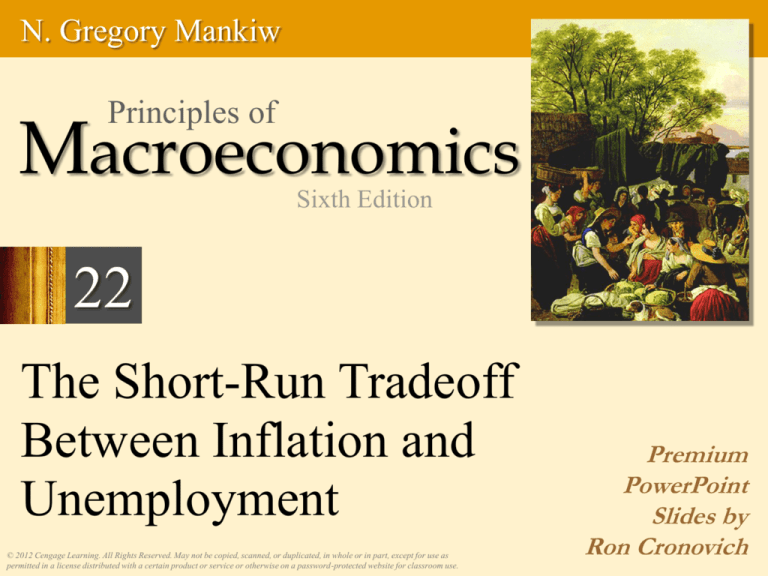
N. Gregory Mankiw
Principles of
Macroeconomics
Sixth Edition
22
The Short-Run Tradeoff
Between Inflation and
Unemployment
© 2012 Cengage Learning. All Rights Reserved. May not be copied, scanned, or duplicated, in whole or in part, except for use as
permitted in a license distributed with a certain product or service or otherwise on a password-protected website for classroom use.
Premium
PowerPoint
Slides by
Ron Cronovich
In this chapter,
look for the answers to these questions:
• How are inflation and unemployment related in
the short run? In the long run?
• What factors alter this relationship?
• What is the short-run cost of reducing inflation?
• Why were U.S. inflation and unemployment both
so low in the 1990s?
© 2012 Cengage Learning. All Rights Reserved. May not be copied, scanned, or duplicated, in whole or in part, except for use as
permitted in a license distributed with a certain product or service or otherwise on a password-protected website for classroom use.
1
Introduction
In the long run, inflation & unemployment are
unrelated:
The inflation rate depends mainly on growth in
the money supply.
Unemployment (the “natural rate”) depends on
the minimum wage, the market power of unions,
efficiency wages, and the process of job search.
One of the Ten Principles:
In the short run, society faces a trade-off
between inflation and unemployment.
© 2012 Cengage Learning. All Rights Reserved. May not be copied, scanned, or duplicated, in whole or in part, except for use as
permitted in a license distributed with a certain product or service or otherwise on a password-protected website for classroom use.
2
The Phillips Curve
Phillips curve: shows the short-run trade-off
between inflation and unemployment
1958: A.W. Phillips showed that
nominal wage growth was negatively
correlated with unemployment in the U.K.
1960: Paul Samuelson & Robert Solow found
a negative correlation between U.S. inflation
& unemployment, named it “the Phillips Curve.”
© 2012 Cengage Learning. All Rights Reserved. May not be copied, scanned, or duplicated, in whole or in part, except for use as
permitted in a license distributed with a certain product or service or otherwise on a password-protected website for classroom use.
3
Deriving the Phillips Curve
Suppose P = 100 this year.
The following graphs show two possible
outcomes for next year:
A. Agg demand low,
small increase in P (i.e., low inflation),
low output, high unemployment.
B. Agg demand high,
big increase in P (i.e., high inflation),
high output, low unemployment.
© 2012 Cengage Learning. All Rights Reserved. May not be copied, scanned, or duplicated, in whole or in part, except for use as
permitted in a license distributed with a certain product or service or otherwise on a password-protected website for classroom use.
4
Deriving the Phillips Curve
A. Low agg demand, low inflation, high u-rate
inflation
P
SRAS
B
105
103
5%
B
A
AD2
A
3%
PC
AD1
Y1
Y2
Y
4%
6%
u-rate
B. High agg demand, high inflation, low u-rate
© 2012 Cengage Learning. All Rights Reserved. May not be copied, scanned, or duplicated, in whole or in part, except for use as
permitted in a license distributed with a certain product or service or otherwise on a password-protected website for classroom use.
5
The Phillips Curve: A Policy Menu?
Since fiscal and mon policy affect agg demand,
the PC appeared to offer policymakers a menu
of choices:
low unemployment with high inflation
low inflation with high unemployment
anything in between
1960s: U.S. data supported the Phillips curve.
Many believed the PC was stable and reliable.
© 2012 Cengage Learning. All Rights Reserved. May not be copied, scanned, or duplicated, in whole or in part, except for use as
permitted in a license distributed with a certain product or service or otherwise on a password-protected website for classroom use.
6
Evidence for the Phillips Curve?
Inflation rate
(% per year)
During the 1960s,
U.S. policymakers
opted for reducing
unemployment
at the expense of
higher inflation
10
8
6
68
4
66
67
2
65
64
0
0
2
4
62
1961
63
6
8
10 Unemployment
rate (%)
© 2012 Cengage Learning. All Rights Reserved. May not be copied, scanned, or duplicated, in whole or in part, except for use as
permitted in a license distributed with a certain product or service or otherwise on a password-protected website for classroom use.
7
The Vertical Long-Run Phillips Curve
1968: Milton Friedman and Edmund Phelps
argued that the tradeoff was temporary.
Natural-rate hypothesis: the claim that
unemployment eventually returns to its normal or
“natural” rate, regardless of the inflation rate
Based on the classical dichotomy and the
vertical LRAS curve (chapters 12 and 17)
© 2012 Cengage Learning. All Rights Reserved. May not be copied, scanned, or duplicated, in whole or in part, except for use as
permitted in a license distributed with a certain product or service or otherwise on a password-protected website for classroom use.
8
The Vertical Long-Run Phillips Curve
In the long run, faster money growth only causes
faster inflation.
P
inflation
LRAS
LRPC
high
inflation
P2
P1
AD2
AD1
low
inflation
u-rate
Y
Natural rate
of output
© 2012 Cengage Learning. All Rights Reserved. May not be copied, scanned, or duplicated, in whole or in part, except for use as
permitted in a license distributed with a certain product or service or otherwise on a password-protected website for classroom use.
Natural rate of
unemployment
9 9
Reconciling Theory and Evidence
Evidence (from ’60s):
PC slopes downward.
Theory (Friedman and Phelps):
PC is vertical in the long run.
To bridge the gap between theory and evidence,
Friedman and Phelps introduced a new variable:
expected inflation – a measure of how much
people expect the price level to change.
© 2012 Cengage Learning. All Rights Reserved. May not be copied, scanned, or duplicated, in whole or in part, except for use as
permitted in a license distributed with a certain product or service or otherwise on a password-protected website for classroom use.
10
The Phillips Curve Equation
Unemp.
rate
=
Natural
rate of –
unemp.
Actual
Expected
–
a
inflation
inflation
Short run
Fed can reduce u-rate below the natural u-rate
by making inflation greater than expected.
Long run
Expectations catch up to reality,
u-rate goes back to natural u-rate whether inflation
is high or low.
© 2012 Cengage Learning. All Rights Reserved. May not be copied, scanned, or duplicated, in whole or in part, except for use as
permitted in a license distributed with a certain product or service or otherwise on a password-protected website for classroom use.
11
The Phillips Curve Equation
Unemp.
rate
=
Natural
rate of –
unemp.
Actual
Expected
–
a
inflation
inflation
From Chapter 20, the SRAS is
See the resemblance? (shouldn’t be the same “a”)
© 2012 Cengage Learning. All Rights Reserved. May not be copied, scanned, or duplicated, in whole or in part, except for use as
permitted in a license distributed with a certain product or service or otherwise on a password-protected website for classroom use.
12
The Phillips Curve Equation
Unemp.
rate
=
Natural
rate of –
unemp.
Actual
Expected
–
a
inflation
inflation
When expected inflation goes up,
1. (Actual inflation – Expected inflation) gets
less positive or even negative
2. -(Actual inflation – Expected inflation)
becomes a smaller negative or even a
positive number
3. Unemployment rate goes up
© 2012 Cengage Learning. All Rights Reserved. May not be copied, scanned, or duplicated, in whole or in part, except for use as
permitted in a license distributed with a certain product or service or otherwise on a password-protected website for classroom use.
13
How Expected Inflation Shifts the PC
Initially, expected &
actual inflation = 3%,
unemployment =
natural rate (6%).
Fed makes inflation
2% higher than expected,
u-rate falls to 4%.
In the long run,
expected inflation
increases to 5%,
PC shifts upward,
unemployment returns to
its natural rate.
inflation
5%
LRPC
B
A
3%
© 2012 Cengage Learning. All Rights Reserved. May not be copied, scanned, or duplicated, in whole or in part, except for use as
permitted in a license distributed with a certain product or service or otherwise on a password-protected website for classroom use.
C
PC2
PC1
4%
6%
u-rate
14
ACTIVE LEARNING
1
A numerical example
Natural rate of unemployment = 5%
Expected inflation = 2%
In PC equation, a = 0.5
A. Plot the long-run Phillips curve.
B. Find the u-rate for each of these values of actual
inflation: 0%, 6%. Sketch the short-run PC.
C. Suppose expected inflation rises to 4%.
Repeat part B.
D. Instead, suppose the natural rate falls to 4%.
Draw the new long-run Phillips curve,
then repeat part B.
© 2012 Cengage Learning. All Rights Reserved. May not be copied, scanned, or duplicated, in whole or in part, except for use as
permitted in a license distributed with a certain product or service or otherwise on a password-protected website for classroom use.
ACTIVE LEARNING
Answers
A fall in the
natural rate
shifts both
curves
to the left.
LRPCD
PCB
7
LRPCA
6
inflation rate
An increase
in expected
inflation
shifts PC to
the right.
1
5
4
PCD
3
PCC
2
1
0
0
1
2
3
4
5
unemployment rate
6
7
8
The Breakdown of the Phillips Curve
Inflation rate
(% per year)
Early 1970s:
unemployment increased,
Friedman &
despite higher inflation.
Phelps’
explanation:
73
expectations
71
69
were catching
70
68
72
up with reality.
66
10
8
6
4
67
2
65
64
0
0
2
4
62
1961
63
6
8
10 Unemployment
rate (%)
© 2012 Cengage Learning. All Rights Reserved. May not be copied, scanned, or duplicated, in whole or in part, except for use as
permitted in a license distributed with a certain product or service or otherwise on a password-protected website for classroom use.
17
Another PC Shifter: Supply Shocks
Supply shock:
an event that directly alters firms’ costs and
prices, shifting the AS and PC curves
Example: large increase in oil prices
© 2012 Cengage Learning. All Rights Reserved. May not be copied, scanned, or duplicated, in whole or in part, except for use as
permitted in a license distributed with a certain product or service or otherwise on a password-protected website for classroom use.
18
How an Adverse Supply Shock Shifts the PC
SRAS shifts left, prices rise, output & employment fall.
inflation
P
SRAS2
P2
SRAS1
B
B
A
A
P1
AD
Y2
Y1
Y
PC2
PC1
u-rate
Inflation & u-rate both increase as the PC shifts upward.
© 2012 Cengage Learning. All Rights Reserved. May not be copied, scanned, or duplicated, in whole or in part, except for use as
permitted in a license distributed with a certain product or service or otherwise on a password-protected website for classroom use.
19
The 1970s Oil Price Shocks
Oil price per barrel
1/1973
$ 3.56
1/1974
10.11
1/1979
14.85
1/1980
32.50
1/1981
38.00
The Fed chose to
accommodate the
first shock in 1973
with faster money growth.
Result:
Higher expected inflation,
which further shifted PC.
1979:
Oil prices surged again,
worsening the Fed’s tradeoff.
© 2012 Cengage Learning. All Rights Reserved. May not be copied, scanned, or duplicated, in whole or in part, except for use as
permitted in a license distributed with a certain product or service or otherwise on a password-protected website for classroom use.
20
The 1970s Oil Price Shocks
Inflation rate
(% per year)
81 75
10
74
8
79
78
6
77
73
4
80
76
1972
Supply
shocks &
rising
expected
inflation
worsened
the PC
tradeoff.
2
0
0
2
4
6
8
10 Unemployment
rate (%)
© 2012 Cengage Learning. All Rights Reserved. May not be copied, scanned, or duplicated, in whole or in part, except for use as
permitted in a license distributed with a certain product or service or otherwise on a password-protected website for classroom use.
21
The Cost of Reducing Inflation
Disinflation: a reduction in the inflation rate
To reduce inflation,
Fed must slow the rate of money growth,
which reduces agg demand.
Short run:
Output falls and unemployment rises.
Long run:
Output & unemployment return to their natural
rates.
© 2012 Cengage Learning. All Rights Reserved. May not be copied, scanned, or duplicated, in whole or in part, except for use as
permitted in a license distributed with a certain product or service or otherwise on a password-protected website for classroom use.
22
Disinflationary Monetary Policy
Contractionary monetary
policy moves economy
inflation
from A to B.
LRPC
Over time,
expected inflation falls,
PC shifts downward.
In the long run,
point C:
the natural rate
of unemployment,
lower inflation.
A
B
C
PC1
PC2
u-rate
natural rate of
unemployment
© 2012 Cengage Learning. All Rights Reserved. May not be copied, scanned, or duplicated, in whole or in part, except for use as
permitted in a license distributed with a certain product or service or otherwise on a password-protected website for classroom use.
23
The Cost of Reducing Inflation
Disinflation requires enduring a period of
high unemployment and low output.
Sacrifice ratio:
percentage points of annual output lost
per 1 percentage point reduction in inflation
Typical estimate of the sacrifice ratio: 5
To reduce inflation rate 1%,
must sacrifice 5% of a year’s output.
Can spread cost over time, e.g.
To reduce inflation by 6%, can either
sacrifice 30% of GDP for one year
sacrifice 10% of GDP for three years
© 2012 Cengage Learning. All Rights Reserved. May not be copied, scanned, or duplicated, in whole or in part, except for use as
permitted in a license distributed with a certain product or service or otherwise on a password-protected website for classroom use.
24
Rational Expectations, Costless Disinflation?
Rational expectations: a theory according to
which people optimally use all the information
they have, including info about govt policies,
when forecasting the future
Early proponents:
Robert Lucas, Thomas Sargent, Robert Barro
Implied that disinflation could be much less
costly…
© 2012 Cengage Learning. All Rights Reserved. May not be copied, scanned, or duplicated, in whole or in part, except for use as
permitted in a license distributed with a certain product or service or otherwise on a password-protected website for classroom use.
25
Rational Expectations, Costless Disinflation?
Suppose the Fed convinces everyone it is
committed to reducing inflation.
Then, expected inflation falls,
the short-run PC shifts downward.
Result:
Disinflations can cause less unemployment
than the traditional sacrifice ratio predicts.
© 2012 Cengage Learning. All Rights Reserved. May not be copied, scanned, or duplicated, in whole or in part, except for use as
permitted in a license distributed with a certain product or service or otherwise on a password-protected website for classroom use.
26
The Volcker Disinflation
Fed Chairman Paul Volcker
Appointed in late 1979 under high inflation &
unemployment
Changed Fed policy to disinflation
1981–1984:
Fiscal policy was expansionary,
so Fed policy had to be very contractionary
to reduce inflation.
Success: Inflation fell from 10% to 4%,
but at the cost of high unemployment…
© 2012 Cengage Learning. All Rights Reserved. May not be copied, scanned, or duplicated, in whole or in part, except for use as
permitted in a license distributed with a certain product or service or otherwise on a password-protected website for classroom use.
27
The Volcker Disinflation
Inflation rate
(% per year)
Disinflation turned out to be very costly
10
u-rate
near 10%
in 1982–83
81
80
1979
8
82
6
84
4
83
85
87
2
86
0
0
2
4
6
8
10 Unemployment
rate (%)
© 2012 Cengage Learning. All Rights Reserved. May not be copied, scanned, or duplicated, in whole or in part, except for use as
permitted in a license distributed with a certain product or service or otherwise on a password-protected website for classroom use.
28
The Greenspan Era
1986: Oil prices fell 50%.
1989–90:
Unemployment fell, inflation rose.
Fed raised interest rates, caused a
mild recession.
1990s:
Unemployment and inflation fell.
Alan Greenspan
Chair of FOMC,
Aug 1987 – Jan 2006
2001: Negative demand shocks
created the first recession in a decade.
Policymakers responded with expansionary monetary
and fiscal policy.
© 2012 Cengage Learning. All Rights Reserved. May not be copied, scanned, or duplicated, in whole or in part, except for use as
permitted in a license distributed with a certain product or service or otherwise on a password-protected website for classroom use.
29
The Greenspan Era
Inflation rate
(% per year)
Inflation and unemployment
were low during most of
Alan Greenspan’s years
as Fed Chairman.
10
8
6
90
05
4
1987
06
2000
2
92
96 02 94
98
0
0
2
4
6
8
10 Unemployment
rate (%)
© 2012 Cengage Learning. All Rights Reserved. May not be copied, scanned, or duplicated, in whole or in part, except for use as
permitted in a license distributed with a certain product or service or otherwise on a password-protected website for classroom use.
30
The Phillips Curve During the
Financial Crisis
The early 2000s housing market
boom turned to bust in 2006
Household wealth fell,
millions of mortgage defaults
and foreclosures, heavy losses
at financial institutions
Result:
Sharp drop in aggregate demand,
steep rise in unemployment
© 2012 Cengage Learning. All Rights Reserved. May not be copied, scanned, or duplicated, in whole or in part, except for use as
permitted in a license distributed with a certain product or service or otherwise on a password-protected website for classroom use.
Ben Bernanke
Chair of FOMC,
Feb 2006 – present
31
FINAL CLICKER QUESTION!!!!!
Who is better looking?
A. Alan Greenspan
B. Ben Bernanke
C. Prof. Zax
D. None of the above
© 2012 Cengage Learning. All Rights Reserved. May not be copied, scanned, or duplicated, in whole or in part, except for use as
permitted in a license distributed with a certain product or service or otherwise on a password-protected website for classroom use.
32
The Phillips Curve During the
Financial Crisis
Inflation rate
(% per year)
The financial crisis caused
aggregate demand to plummet,
sharply increasing unemployment
and reducing inflation
10
8
6
4
2006
2007
2
2008
2009
0
0
2
4
6
8
10 Unemployment
rate (%)
CONCLUSION
The theories in this chapter come from some of
the greatest economists of the 20th century.
They teach us that inflation and unemployment
are
unrelated in the long run
negatively related in the short run
affected by expectations,
which play an important role in the economy’s
adjustment from the short-run to the long run
© 2012 Cengage Learning. All Rights Reserved. May not be copied, scanned, or duplicated, in whole or in part, except for use as
permitted in a license distributed with a certain product or service or otherwise on a password-protected website for classroom use.
34
S U MMA RY
• The Phillips curve describes the short-run
tradeoff between inflation and unemployment.
• In the long run, there is no tradeoff:
inflation is determined by money growth,
while unemployment equals its natural rate.
• Supply shocks and changes in expected inflation
shift the short-run Phillips curve, making the
tradeoff more or less favorable.
© 2012 Cengage Learning. All Rights Reserved. May not be copied, scanned, or duplicated, in whole or in part, except for use as
permitted in a license distributed with a certain product or service or otherwise on a password-protected website for classroom use.
S U MMA RY
• The Fed can reduce inflation by contracting the
money supply, which moves the economy along
its short-run Phillips curve and raises
unemployment. In the long run, though,
expectations adjust and unemployment returns
to its natural rate.
• Some economists argue that a credible
commitment to reducing inflation can lower the
costs of disinflation by inducing a rapid
adjustment of expectations.
© 2012 Cengage Learning. All Rights Reserved. May not be copied, scanned, or duplicated, in whole or in part, except for use as
permitted in a license distributed with a certain product or service or otherwise on a password-protected website for classroom use.


